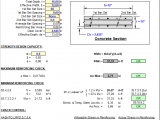
Strap Footing BSI 8110 Spreadsheet
19 July 2025Table of Contents
Strap Footing BSI 8110 Spreadsheet
Building a strong and stable structure starts from the ground up. While several foundation types exist, the strap footing is a particularly clever solution for challenging construction scenarios.[1] If you’re dealing with property line constraints or eccentrically loaded columns, understanding the role and benefits of a strap footing can save you from future structural headaches and ensure the longevity of your build.
A strap footing, also known as a cantilever footing, is a type of combined foundation that connects two or more separate footings with a rigid concrete beam called a strap.[2][3] This design is engineered to distribute the weight of the structure evenly, especially when one column is too close to a property boundary, making a traditional isolated footing impractical.[2][3]
When Does a Strap Footing Make Sense?
Strap footings are not a one-size-fits-all solution, but they are the ideal choice in several specific situations:
-
Proximity to Property Lines: When a column is located at the very edge of a property, its footing cannot extend into the neighboring lot.[4][5] This creates an off-center (eccentric) load on the footing, causing it to tilt. A strap beam connects this exterior footing to an adjacent interior footing, counteracting the tilting force and ensuring stability.[3]
-
Uneven Soil Conditions: On sites where the soil’s bearing capacity varies, a strap footing helps to distribute loads evenly across the different soil conditions, preventing one part of the foundation from settling more than another.[2][5]
-
Large Column Spacing: When the distance between two columns is too great for a conventional combined footing to be economical, a strap footing can be a more practical and cost-effective option.[6][7] This is because a combined footing would become excessively long and narrow, requiring significant excavation.[6]
-
Heavy or Irregular Loads: For buildings with heavy or irregularly spaced loads, such as large warehouses or high-rise apartments, strap footings help to share the weight evenly and prevent structural collapse.[1]
The Anatomy of a Strap Footing
A strap footing system consists of a few key components working in unison:
-
Isolated Footings: These are the individual concrete pads that sit beneath each column.
-
Strap Beam: This is the reinforced concrete beam that connects the isolated footings.[2] Crucially, the strap beam is designed to be very rigid and typically does not bear directly on the soil beneath it.[6][8] This ensures it acts as a lever, transferring forces between the footings without taking on any soil pressure itself.[6]
-
Columns: These are the vertical structural elements that transfer the building’s load down to the footings.
The fundamental design principle is to proportion the footing areas so that the pressure under both footings is equal and uniform.[6][9] This ensures the center of gravity of the combined loads aligns with the center of gravity of the two footings.[9]
How is a Strap Footing Constructed?
The construction process for a strap footing requires careful planning and execution:
-
Excavation: The areas for the individual footings and the connecting strap beam are dug out.[1]
-
Formwork: Wooden or metal forms are set in place to create the mold for the concrete.[1]
-
Reinforcement: Steel reinforcement bars (rebar) are placed inside the forms to give the concrete tensile strength.[1]
-
Concrete Pouring: Concrete is poured into the forms for the footings and the strap beam.[1]
-
Curing and Form Removal: Once the concrete has hardened sufficiently, the forms are removed.[1]
A key step in the process is to ensure the soil under the strap beam is loosened or that the beam is constructed slightly above the ground to prevent it from bearing on the soil.[6][10]
Advantages and Disadvantages of Strap Footings
Like any construction method, strap footings have their own set of pros and cons.
Advantages:
-
Prevents Uneven Settlement: The strap beam effectively distributes weight, reducing the risk of differential settlement and potential foundation damage.[5]
-
Space Efficient: They are an ideal solution for construction sites with limited space, allowing for stable foundations near property lines without encroaching on adjacent land.[5]
-
Manages Eccentric Loads: Strap footings are specifically designed to counteract the moment created by off-center loads, preventing the footing from tilting.[6]
-
Enhanced Stability: By connecting footings, the overall foundation system becomes more robust and durable.[2]
Disadvantages:
-
Increased Complexity: The design calculations for shear forces, moments, and pressure distribution can be more complex and time-consuming compared to simpler footing types.[6]
-
Higher Cost: Due to the additional materials like the strap beam and the more intricate construction process, strap footings can be more expensive than isolated or strip footings.[11]
Strap Footing vs. Other Foundation Types
To better understand the unique role of strap footings, here’s a quick comparison with other common foundation types:
| Footing Type | Description | Best For |
| Strap Footing | Two or more isolated footings connected by a strap beam.[3] | Eccentrically loaded columns, construction near property lines, and uneven soil conditions.[2][3] |
| Isolated Footing | A single footing supporting an individual column.[7] | Supporting single columns where loads are relatively light and soil conditions are uniform. |
| Combined Footing | A single footing supporting two or more columns.[7] | Columns that are close together, preventing the use of individual footings.[7] |
| Strip Footing | A continuous strip of concrete that supports a load-bearing wall.[7] | Load-bearing walls in residential and low-rise buildings with good soil conditions.[12] |
| Raft or Mat Foundation | A large, single slab of concrete that covers the entire footprint of the building. | Weak soil conditions or when building loads are very heavy, as it distributes the load over the largest possible area. |
In essence, a strap footing is a specialized type of combined footing, but the key difference is the presence of the connecting strap beam that is intentionally kept free from soil contact.[13][14]
The Bottom Line
For challenging building sites, the strap footing is an invaluable tool in a structural engineer’s arsenal. It provides a reliable and effective solution for dealing with eccentric loads and property line constraints. By ensuring a balanced distribution of weight, strap footings contribute significantly to the long-term stability and safety of a structure.[2] If your project involves any of the tricky scenarios mentioned, a strap footing might be the perfect foundation to build upon.


